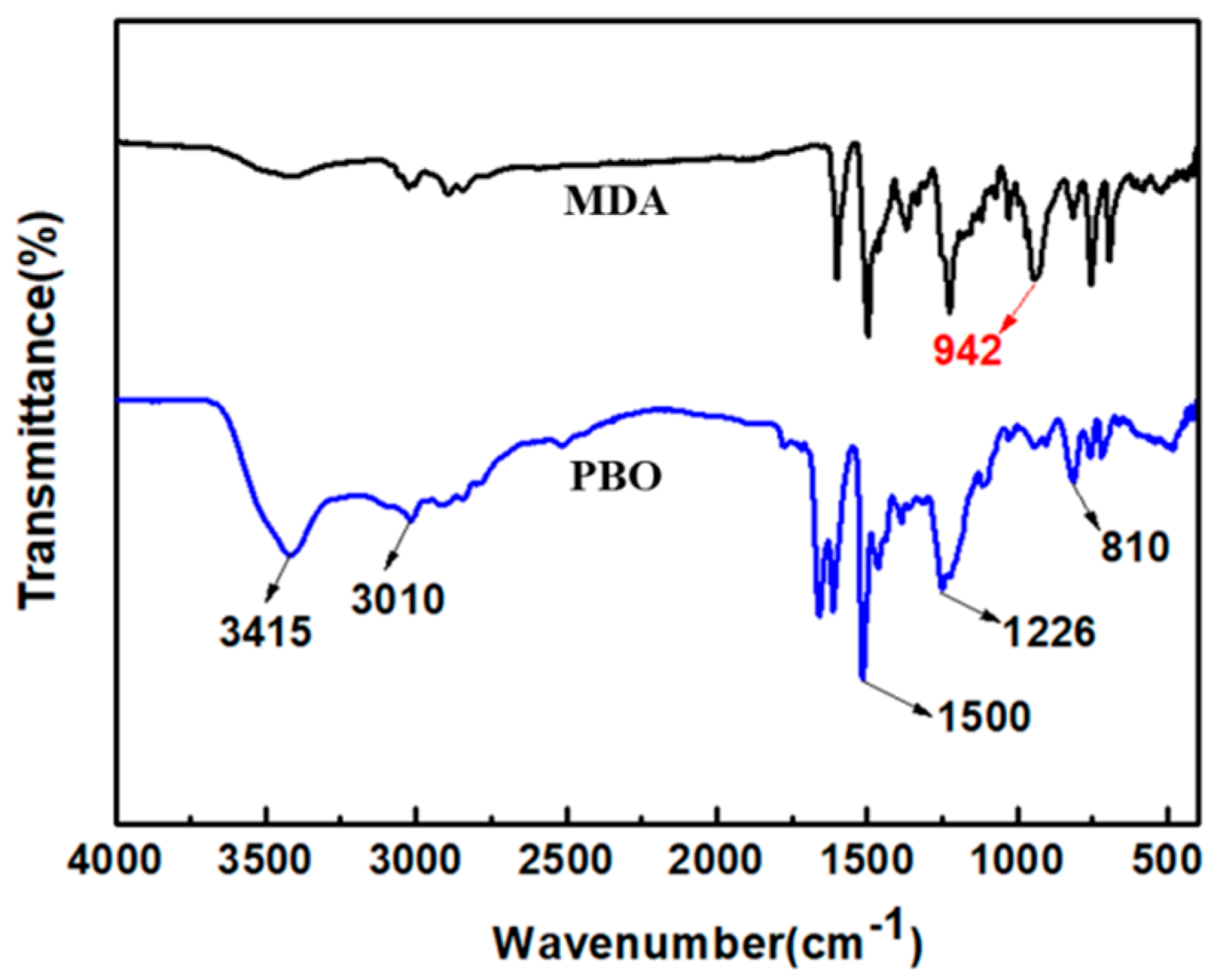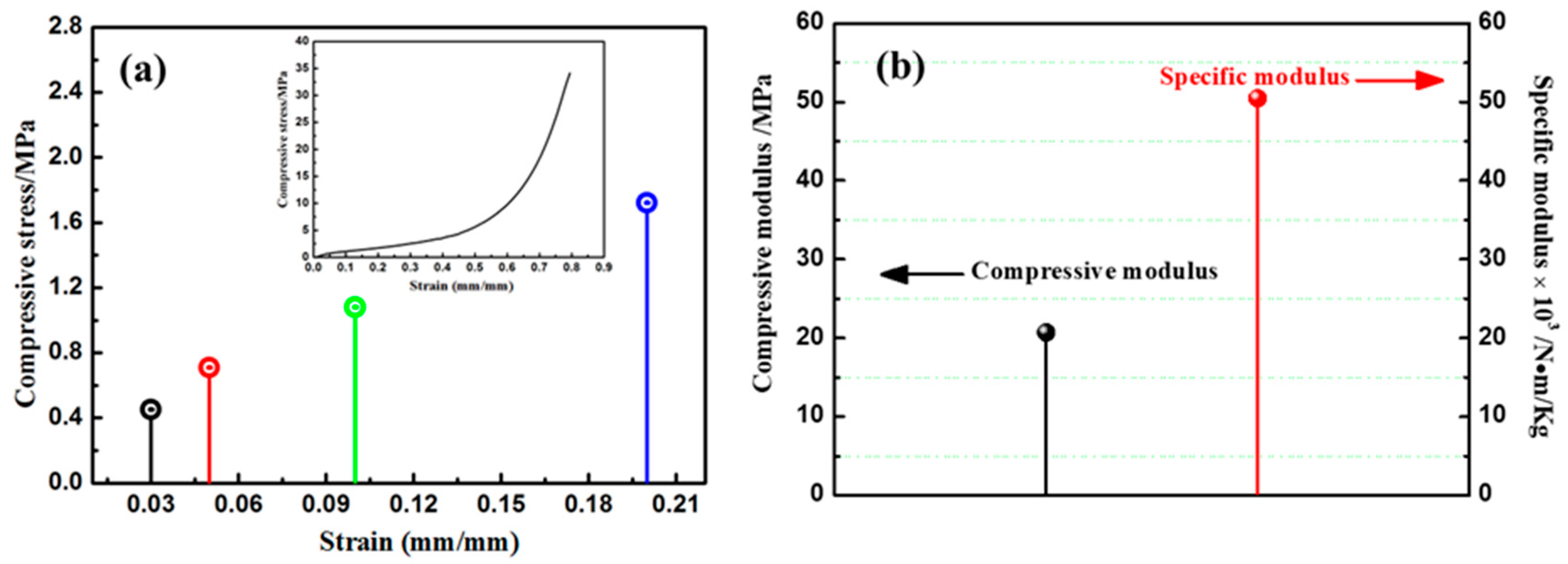Compressible, Flame-Resistant and Thermally Insulating Fiber-Reinforced Polybenzoxazine Aerogel Composites
Abstract
1. Introduction
2. Experimental Section
3. Results and Discussion
4. Conclusions
Author Contributions
Funding
Acknowledgments
Conflicts of Interest
References
- Wong, J.C.H.; Kaymak, H.; Brunner, S.; Koebel, M. Mechanical properties of monolithic silica aerogels made from polyethoxydisiloxanes. Micropor. Mesopor. Mater. 2014, 183, 23–29. [Google Scholar] [CrossRef]
- Ibrahim, M.; Biwole, P.H.; Wurtz, E.P.; Archard, P. A study on the thermal performance of exterior walls covered with a recently patented silica-aerogel-based insulating coating. Build. Environ. 2014, 81, 112–122. [Google Scholar] [CrossRef]
- Stahl, T.; Brunner, S.; Zimmermann, M.; Wakili, K.G. Thermo-hygric properties of a newly developed aerogel-based insulation rendering for both exterior and interior applications. Energy Build. 2012, 44, 114–117. [Google Scholar] [CrossRef]
- Zhou, T.; Cheng, X.; Pan, Y.; Li, C.; Gong, L.; Zhang, H. Mechanical performance and thermal stability of glass fiber reinforced silica aerogel composites based on co-precursor method by freeze drying. Appl. Surf. Sci. 2018, 437, 321–328. [Google Scholar] [CrossRef]
- Shafi, S.; Navik, R.; Ding, X.; Zhao, Y. Improved heat insulation and mechanical properties of silica aerogel/glass fiber composite by impregnating silica gel. J. Non Cryst. Solids 2019, 503, 78–83. [Google Scholar] [CrossRef]
- Baumann, T.F.; Gash, A.E.; Chinn, S.C.; Sawvel, A.M.; Maxwell, R.S.; Satcher, J.H. Synthesis of high-surface-area alumina aerogels without the use of alkoxide precursors. Chem. Mater. 2005, 17, 395–401. [Google Scholar] [CrossRef]
- Zu, G.; Shen, J.; Zou, L.; Wang, W.; Lian, Y.; Zhang, Z.; Du, A. Nanoengineering super heat-resistant, strong alumina aerogels. Chem. Mater. 2013, 25, 4757–4764. [Google Scholar] [CrossRef]
- Liang, H.-W.; Guan, Q.F.; Chen, L.-F.; Zhu, Z.; Zhang, W.J.; Yu, S.H. Macroscopic-scaletemplate synthesis of robust carbonaceous nanofiber hydrogels and aerogels and their applications. Angew. Chem. Int. Ed. 2012, 51, 5101–5105. [Google Scholar] [CrossRef]
- Zhang, S.; Feng, J.; Feng, J.; Jiang, Y. Formation of enhanced gelatum using ethanol/water binary medium for fabricating chitosan aerogels with high specific surface area. Chem. Eng. J. 2017, 309, 700–707. [Google Scholar] [CrossRef]
- Chidambareswarapattar, C.; McCarver, P.M.; Luo, H.; Lu, H.; Sotiriou-Leventis, C. Fractal multiscale nanoporous polyurethanes: Flexible to extremely rigid aerogels from multifunctional small molecules. Chem. Mater. 2013, 25, 3205–3224. [Google Scholar] [CrossRef]
- Diascorn, N.; Calas, S.; Sallée, H.; Archard, P.; Rigacci, A. Polyurethane aerogels synthesis for thermal insulation-textural, thermal and mechanical properties. J. Supercrit. Fluid 2015, 106, 76–84. [Google Scholar] [CrossRef]
- Ye, D.D.; Wang, T.; Liao, W.; Wang, H.; Zhao, H.-B.; Wang, Y.-T.; Xu, S.; Wang, Y.-Z. Ultrahigh-temperature insulating and fire-resistant aerogels from cationic amylopectin and clay via a facile route. ACS Sustain. Chem. Eng. 2019, 7, 11582–11592. [Google Scholar] [CrossRef]
- Li, X.L.; Chen, M.J.; Chen, H.B. Facile fabrication of mechanically strong and flame-retardant alginate/clay aerogels. Compos. B Eng. 2019, 164, 18–25. [Google Scholar] [CrossRef]
- Carosio, F.; Maddalena, L.; Gomez, J.; Saracco, G.; Fina, A. Graphene oxide exoskeleton to produce self-extinguishing, nonignitable, and flame-resistant flexible foams: A mechanically tough alternative to inorganic aerogels. Adv. Mater. Interfaces 2018, 5. [Google Scholar] [CrossRef]
- Wu, N.; Niu, F.; Lang, W.; Xia, M. Highly efficient flame-retardant and low-smoke-toxicity poly(vinylalcohol)/alginate/montmorillonite composite aerogels by two-step crosslinking strategy. Carbohyd. Polym. 2019, 221, 221–230. [Google Scholar] [CrossRef]
- Wang, L.; Sánchez-Soto, M.; Fan, J.; Xia, Z.-P.; Liu, Y. Boron/nitrogen flame retardant additives cross-linked cellulose nanofibril/montmorillonite aerogels toward super-low flammability and improved mechanical properties. Polym. Adv. Technol. 2019, 30, 1807–1817. [Google Scholar] [CrossRef]
- Xu, L.; Li, L.; Chen, Y. Research of aerogel in flame retardant field. Sci. Sin. Chim. 2019, 49, 266–275. [Google Scholar] [CrossRef]
- Thubsuang, U.; Ishida, H.; Wongkasemjit, S.; Chaisuwan, T. Advanced and economical ambient drying method for controlled mesopore polybenzoxazine-based carbon xerogels: Effects of non-ionic and cationic surfactant on porous structure. J. Colloid Interf. Sci. 2015, 459, 241–249. [Google Scholar] [CrossRef]
- Ertas, Y.; Uyar, T. Fabrication of cellulose acetate/polybenzoxazine cross-linked electrospun nanofibrous membrane for water treatment. Carbohyd. Polym. 2017, 177, 378–387. [Google Scholar] [CrossRef]
- Ghosh, N.N.; Kiskan, B.; Yagci, Y. Polybenzoxazines—New high-performance thermosetting resins: Synthesis and properties. Prog. Polym. Sci. 2007, 32, 1344–1391. [Google Scholar] [CrossRef]
- Lorjai, P.; Chaisuwan, T.; Wongkasemjit, S. Porous structure of polybenzoxazine-based organic aerogel prepared by sol–gel process and their carbon aerogels. J. Sol-Gel. Sci. Technol. 2009, 52, 56–64. [Google Scholar] [CrossRef]
- Gu, S.; Li, Z.; Miyoshi, T.; Jana, S.C. Polybenzoxazine aerogels with controllable pore structures. RSC Adv. 2015, 5, 26801–26805. [Google Scholar] [CrossRef]
- Xiao, Y.; Li, L.; Zhang, S.; Feng, J.; Jiang, Y.; Feng, J. Thermally insulating polybenzoxazine aerogels based on 4,4 ’-diamino-diphenylmethane benzoxazine. J. Mater. Sci. 2019, 54, 12951–12961. [Google Scholar] [CrossRef]
- Shen, X.; Dai, J.; Liu, Y.; Liu, X. Synthesis of high performance polybenzoxazine networks from bio-based furfurylamine: Furan vs benzene ring. Polymer 2017, 122, 258–269. [Google Scholar] [CrossRef]
- Plastics-determination of Burning Behaviour by Oxygen Index- Part 2: Ambient-temperature Test; ISO 4589-2: 1996/Amd. 1:2005(E). Technical Committee ISO/TC.61; ISO: GeneVa, Switzerland, 2005.
- Fang, B.; Lu, X.C.; Hu, J.Y. pH controlled green luminescent carbon dots derived from benzoxazine monomers for the fluorescence turn-on and turn-off detection. J. Colloid Interf. Sci. 2019, 536, 516–525. [Google Scholar] [CrossRef] [PubMed]
- Mahadik-Khanolkar, S.; Donthula, S.; Sotiriou-Leventis, C.; Leventis, N. Polybenzoxazine Aerogels. 1. high-yield room-temperature acid-catalyzed synthesis of robust monoliths, oxidative aromatization, and conversion to microporous carbons. Chem. Mater. 2014, 26, 1303–1317. [Google Scholar] [CrossRef]
- Takeichi, T.; Guo, Y.; Rimdusit, S. Performance improvement of polybenzoxazine by alloying with polyimide: Effect of preparation method on the properties. Polymer 2005, 46, 4909–4916. [Google Scholar] [CrossRef]
- Chiang, C.-L.; Ma, C.-C.M.; Wu, D.-L.; Kuan, H.-C. Preparation, characterization, and properties of novolac-type phenolic/SiO2 hybrid organic–inorganic nanocomposite materials by sol–gel method. J. Polym. Sci. A 2003, 41, 905–913. [Google Scholar] [CrossRef]
- Motahari, S.; Motlagh, G.H.; Moharramzadeh, A. Thermal and flammability properties of polypropylene/silica aerogel composites. J. Macromol. Sci. B 2015, 54, 1081–1091. [Google Scholar] [CrossRef]
- Guo, W.; Liu, J.; Zhang, P.; Song, L. Multi-functional hydroxyapatite/polyvinyl alcohol composite aerogels with self-cleaning, superior fire resistance and low thermal conductivity. Compos. Sci. Technol. 2018, 158, 128–136. [Google Scholar] [CrossRef]
- Shang, K.; Liao, W.; Wang, Y. Thermally stable and flame-retardant poly (vinyl alcohol)/montmorillonite aerogel via a facile heat treatment. Chin. Chem. Lett. 2018, 29, 433–436. [Google Scholar] [CrossRef]
- Wang, C.H.; Cheng, H.M.; Hong, C.Q.; Zhang, X.; Zeng, T. Lightweight chopped carbon reinforced silica-phenolic resin aerogel nanocomposite: Facile preparation, properties and application to thermal protection. Compos. Part A Appl. Sci. Manuf. 2018, 112, 81–90. [Google Scholar] [CrossRef]





| Samples | Average Thermal Conductivities (W/m·K) | ||||
|---|---|---|---|---|---|
| 22 °C | 50 °C | 75 °C | 100 °C | ||
| Composites | 5 Pa | 0.031 | 0.035 | 0.044 | 0.049 |
| 105 Pa | 0.069 | 0.072 | 0.075 | 0.077 | |
| PBO aerogels | 5 Pa | 0.028 | 0.030 | 0.032 | 0.036 |
| 105 Pa | 0.050 | 0.055 | 0.063 | 0.064 | |
© 2020 by the authors. Licensee MDPI, Basel, Switzerland. This article is an open access article distributed under the terms and conditions of the Creative Commons Attribution (CC BY) license (http://creativecommons.org/licenses/by/4.0/).
Share and Cite
Xiao, Y.; Li, L.; Liu, F.; Zhang, S.; Feng, J.; Jiang, Y.; Feng, J. Compressible, Flame-Resistant and Thermally Insulating Fiber-Reinforced Polybenzoxazine Aerogel Composites. Materials 2020, 13, 2809. https://doi.org/10.3390/ma13122809
Xiao Y, Li L, Liu F, Zhang S, Feng J, Jiang Y, Feng J. Compressible, Flame-Resistant and Thermally Insulating Fiber-Reinforced Polybenzoxazine Aerogel Composites. Materials. 2020; 13(12):2809. https://doi.org/10.3390/ma13122809
Chicago/Turabian StyleXiao, Yunyun, Liangjun Li, Fengqi Liu, Sizhao Zhang, Junzong Feng, Yonggang Jiang, and Jian Feng. 2020. "Compressible, Flame-Resistant and Thermally Insulating Fiber-Reinforced Polybenzoxazine Aerogel Composites" Materials 13, no. 12: 2809. https://doi.org/10.3390/ma13122809
APA StyleXiao, Y., Li, L., Liu, F., Zhang, S., Feng, J., Jiang, Y., & Feng, J. (2020). Compressible, Flame-Resistant and Thermally Insulating Fiber-Reinforced Polybenzoxazine Aerogel Composites. Materials, 13(12), 2809. https://doi.org/10.3390/ma13122809





